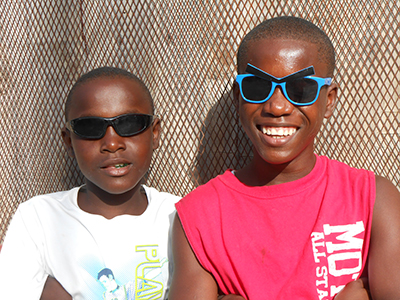Video: Architect Builds Homes, Relationships in Haiti
-
-
slice.mit.edu
- 1
Filed Under
Five years ago, Haiti was flattened by a devastating earthquake. Back in Cambridge, Paul Fallon ’77, SM ’81, MArch ’81 felt a special need to act in his role as an architect.
He attributes the massive loss of life to faulty architecture and poor construction practices. “So many people died because of the buildings,” said Fallon in a new Alumni Association video. “That’s something that I felt a personal responsibility for.”
Fallon, who had been to Haiti many times through volunteer service trips, visited again after the earthquake. “Their world was difficult before the earthquake, and it is difficult now, albeit in different ways,” he said in a November Boston Globe Magazine article.
Fallon helped design and build the Be Like Brit orphanage, named after Britney Gengel, an American casualty of the earthquake who had been on a service trip. In her last text to her parents, she told them of her dream to build an orphanage in Haiti, and her parents set about to build one in her honor. The orphanage is now home to 66 children.

He also served as the architect and helped train local workers in earthquake-resistant building practices for the construction of the Mission of Hope School. Eight of the school’s 12 classrooms have already been built teaching 500 children, with space for 100 more students once the school is completed.
Beyond permanent structures, Fallon has built permanent relationships. While working on one project he met Dieunison, a young Haitian recently orphaned by the quake and living on the streets.
“I was adopted by a little kid,” he jokes in a recent MIT Alum Books podcast. Fallon now supports Dieunison and his half-brother Dieurie in attending school. “What serves them and Haiti well is the opportunity for people with their energy, instincts, and capabilities to develop educational and training skills and stay in Haiti and help to improve Haiti,” he said.

Fallon is not the only MIT community member sharing his skills to rebuild Haiti. Students developed Konbit, an open source platform for NGOs to find local workers. And many students and alumni continue to volunteer in service projects aiding in rebuilding efforts through MIT’s Public Service Center.
Listen to Paul Fallon discuss his new book Architecture by Moonlight in the MIT Alum Books podcast and at tonight’s 6:30 p.m. talk at the Main Cambridge Public Library. Watch Fallon talk about his experiences in Haiti in a new MITAA video produced by Brielle Domings.
Five years ago, Haiti was flattened by a devastating earthquake. Back in Cambridge, Paul Fallon ’77, SM ’81, MArch ’81 felt a special need to act in his role as an architect.
He attributes the massive loss of life to faulty architecture and poor construction practices. “So many people died because of the buildings,” said Fallon in a new Alumni Association video. “That’s something that I felt a personal responsibility for.”
Fallon, who had been to Haiti many times through volunteer service trips, visited again after the earthquake. “Their world was difficult before the earthquake, and it is difficult now, albeit in different ways,” he said in a November Boston Globe Magazine article.
Fallon helped design and build the Be Like Brit orphanage, named after Britney Gengel, an American casualty of the earthquake who had been on a service trip. In her last text to her parents, she told them of her dream to build an orphanage in Haiti, and her parents set about to build one in her honor. The orphanage is now home to 66 children.

He also served as the architect and helped train local workers in earthquake-resistant building practices for the construction of the Mission of Hope School. Eight of the school’s 12 classrooms have already been built teaching 500 children, with space for 100 more students once the school is completed.
Beyond permanent structures, Fallon has built permanent relationships. While working on one project he met Dieunison, a young Haitian recently orphaned by the quake and living on the streets.
“I was adopted by a little kid,” he jokes in a recent MIT Alum Books podcast. Fallon now supports Dieunison and his half-brother Dieurie in attending school. “What serves them and Haiti well is the opportunity for people with their energy, instincts, and capabilities to develop educational and training skills and stay in Haiti and help to improve Haiti,” he said.

Fallon is not the only MIT community member sharing his skills to rebuild Haiti. Students developed Konbit, an open source platform for NGOs to find local workers. And many students and alumni continue to volunteer in service projects aiding in rebuilding efforts through MIT’s Public Service Center.
Listen to Paul Fallon discuss his new book Architecture by Moonlight in the MIT Alum Books podcast and at tonight’s 6:30 p.m. talk at the Main Cambridge Public Library. Watch Fallon talk about his experiences in Haiti in a new MITAA video produced by Brielle Domings.








Comments
Hank Valcour '56
Mon, 01/12/2015 5:45am
I began my travels to Haiti as part of a church support group working near Les Cayes (some 150 miles SW of Port au Prince).
My last trip to Haiti was with a group from UMass Lowell who have established a development center in Les Cayes. Focus is on providing advanced education.
Haiti needs all the help they can get.
Hank